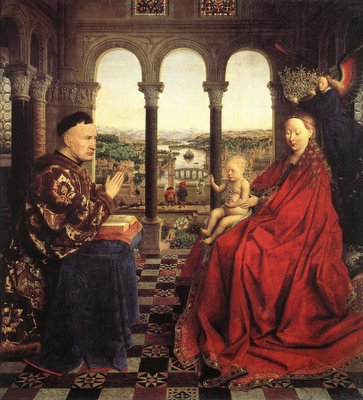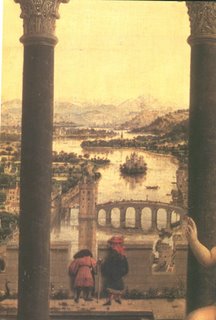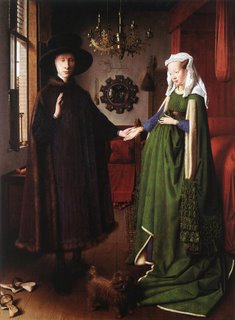
That's Chancellor Rolin, who paid for the painting, adoring the child Jesus. What really makes the painting so enchanting for me, personally, is the detail in the background, in the courtyard outside the little room. Here's a close-up:

As you can see, Van Eyck has painted a peacock (far bottom left of the close-up), flowers and some scraggly shrubbery; a ship; and a bridge (with people on it!). If you like you can click on the first picture and see a larger image; then you'll note that he also depcits an entire city on both sides of the river, complete with a church on the left bank, its steeple rising above the shorter buildings.
Of course, one doesn't see such detail when just glancing at the painting; at first, one just notices that this is a portrait of the Chancellor, hands folded in prayer, adoring the infant Christ, who is seated on His Mother's lap. Only a careful viewing reveals the intricate little world in the background.
Another example, which most people who have ever taken an art history course are probably familiar with, is Van Eyck's Portrait of Giovanni Arnolfini and his Wife, which is in the National Gallery at London:

If you check out the background detail in the middle of the painting, you can see where Van Eyck has painted the reflection of Signor and Signora Arnolfini in a mirror:

The use of perspective is, of course, genius. The rigorous attention to detail in some ways reminds me of the great cathedral-builders, who put just as much effort into crafting and decorating the very top of the insides of churches as they did the lower portions, even though no human being who entered the building would be able to see that high up or notice that the work had been done. So why did they bother? Their work was meant to glorify God, not simply please man.
Ahem. The Northern Renaissance produced this kind of art. The 20th century, on the other hand, produced... Dada.
::Screams in pain::
Pictures from the Web Gallery of Art.




















No comments:
Post a Comment